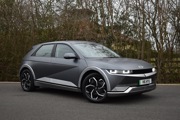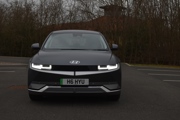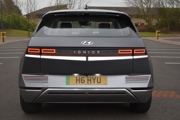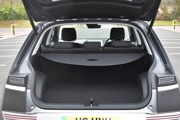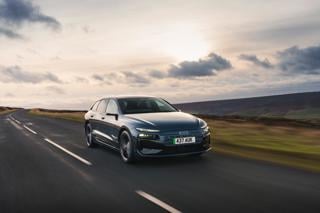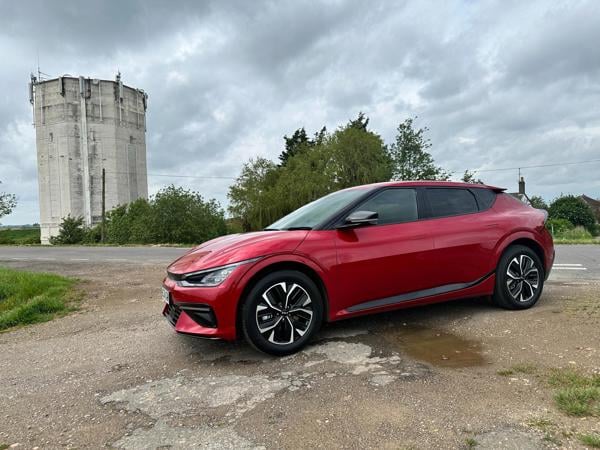Review
Our Hyundai Ioniq 5 has had its software update, removing the gremlin which regularly pinged a warning that the advanced driver assistance system had disengaged, courtesy of Smiths Hyundai in Peterborough.
Full marks for the service, which included a video report on the brakes and tyres. Smiths also sorted the passenger seat rattle and attempted a fix on the rear seatbelts, albeit with only minimal success – i.e. they still rattle against the C pillar, just not as loudly. I’ve resorted to the previous solution of keeping them plugged in when not in use.
For our sixth and final report, we’re focusing on running costs and rival comparisons.
Setting the benchmark, the £43,035 Ioniq 5 Premium 73kWh RWD (WLTP range 300 miles) costs 46.64ppm over four years/80,000 miles, according to the Fleet News running cost calculator (data from AutoTrader), consisting of fuel 7.58ppm, depreciation 35.89ppm and SMR 3.2ppm.
We’re comparing it against the Skoda Enyaq, Volkswagen ID4 and Toyota bZ4X, but it also rivals the Tesla Model 3 and stablemate Kia’s EV6.
First the Skoda. Weighing in at £43,580 (Lounge Auto spec), this bigger battery option (82kWh – range of 333 miles) means a fuel saving at 7.07ppm, but higher SMR at 3.70ppm. The big difference is depreciation, at 33.93ppm, resulting in a running cost of 44.70ppm – the lowest of the four cars in this comparison basket.
The ID4 figures largely mirror the Ioniq 5, with the £43,605 Life Edition (77kWh – range of 310 miles) costing 45.79ppm (fuel 7.49ppm; depreciation 34.90ppm; SMR 3.4ppm).
The recently launched bZ4X, meanwhile, costs 45.69ppm for the £43,725 Pure edition (71.4kWh – range of 317 miles). It wins on fuel (6.51ppm) and is second only to the Enyaq on depreciation (34.68ppm), but is the most costly of the four cars to maintain (4.8ppm).
Interestingly, while not strictly like-for-like, when comparing the Ioniq 5 with the 1.6-litre diesel Tucson in premium spec, the scales are tipped overwhelmingly in the favour of electric.
The £35,335 Tucson has lower depreciation, at 28.84ppm, but more than double the fuel cost, at 16.91ppm, and SMR, at 5ppm, for a total running cost of 50.79ppm.
Over four years/80,000 miles, the Tucson would cost around £9,000 more than the Ioniq 5.
Remote services enhance ownership experience
I discovered a near life saving innovation on the Hyundai Ioniq 5 last month. Walk towards the car while pressing down the lock button and the hold button on the key fob for three seconds and the car will start up the aircon for a few moments of icy blast to prevent the furnace blast when you open the door.
The timing was perfect as temperatures soared towards a new UK record, and it also saved a bit of battery power as the car remained plugged in while the heat dropped.
I’ve since signed into the Hyundai app, called Bluelink, which has opened up a host of additional features.
They include the ability to lock and unlock the car remotely, receive a notification if the alarm is triggered and run a diagnostics check on tyre pressure, brakes and airbags.
Sat-nav/mapping highlights include planning your journey remotely and sending the route to the car, navigating the final mile or so to your destination on foot and a car locator.
You can also set the temperature, the charging schedule to prolong battery life and cheapest rates, and limits for fast and overall charging.
There are even personal elements, such as a summary of trips, including distance, journey times and average speed, plus calendar synchronisation and app personalisation.
It’s very useful and keeps you connected to key functionality while away from the car.
A piece of technology that isn’t winning us over is the lane keep assist, which is overly aggressive. It’s been an issue on other test cars, too, but the Ioniq’s is one of the worst we’ve experienced. While driving safely within your own lane around a bend, it can, with no warning, jerk the steering wheel hard towards the side of the road.
Now, the first thing I do when getting into the car is switch the system off by using the button on the steering wheel. Problem solved.
Nevertheless, the Ioniq 5 does possess a full five-star EuroNCAP rating, with an 88% score for adults, 86% for children, 63% for vulnerable road users and 88% for its safety systems.
Bigger than it looks
The Ioniq 5 is deceptively big. The photos suggest Golf-size; in reality it has a larger footprint than the Tucson SUV, resulting in a very large family car.
But it doesn’t just deceive in the looks. It’s the same when driving. Such is the ease with which the Ioniq navigates urban streets and winding roads alike, it’s easy to forget you are driving such a voluminous vehicle. It’s brought home when reverse parking – on several occasions I’ve misjudged the line, resulting in one of those embarrassing shuffles forward to readjust.
The dimensions – 4,635 long and 1,890 wide, with a three-metre wheelbase – give a king-sized cabin for five, with lots of additional storage room thanks to the absence of the transmission tunnel between driver and front seat passenger.

The Ioniq 5 is the first Hyundai to be built on the new electric global modular platform (E-GMP) which positions the battery pack within the wheelbase for improved weight distribution and a low centre of gravity.
This enabled Hyundai to recreate the interior as – in its words – a “whole new in-car experience”. It certainly adds some neat flourishes with a larger flat floor, fully reclinable front seats (for a nap while charging, apparently), reclining rear seats, and a sliding centre console that can be moved back to be used as a table or desk by rear passengers.
The E-GMP also accommodates a decent boot capacity of 527 litres, with additional storage under the front bonnet. The boot is wide but quite shallow and you’ll need to retract the parcel shelf to fit larger items.
In our previous review, we revealed some of the niggles we’d encountered in our first three months with the Ioniq 5. Hyundai has been in touch to say the issue with the advanced driver assistance systems (ADAS) – which regularly disengaged each item in turn, such as lane-keeping and collision avoidance, before reactivating them a few moments later – required a simple software update.
Software glitches and rattles are apparent
We’re onto test three of our Hyundai Ioniq 5, having taken delivery 15 weeks ago, and have identified a few quality/design annoyances and software glitches which are slightly impacting on our enjoyment of this impressive car.
First some positives; average efficiency is now sitting proudly at 4mi/kWh, putting the Ioniq’s range at around 280 miles (although full charge is displaying between 275 and 290). Peak performance on a single journey, (25 miles) is now 5.1, although I did also achieve a short trip (eight miles) high of 5.3.
I’ve also had my first, very positive, experience of public charging – well, destination charging to be more precise - at a hotel we were using for a fleet roundtable. The PodPoint was easy to pay for via the app and I received a receipt on email as soon as I finished charging.
Now the issues. They range from the minor - the rear windscreen is a dust and dirt magnet and needs cleaning almost daily (no rear wiper, sadly) - to the more worrying, such as the ADAS software which several times a week for the past month has been disengaging each item in turn, such as lane keeping and collision avoidance, before reactivating them a few moments later.
It seems to be a software glitch which happens mainly on sunny days (hay fever?) and I’m not entirely convinced any safety systems have actually been switched off – but it’s unnerving when it happens. Hyundai has been alerted.
Then there is the downright annoying. The passenger seat, when unoccupied, rattles in its holding over every bump. And the rear seat belts sit to the side of the seat when not in use clanking against the C pillar, which is an issue raised in several driver forums. This, admittedly, is easily resolved by leaving them plugged in.
I’m hopeful that passenger seat problem is down to my individual car rather than an Ioniq 5 issue as a Google search doesn’t return any results. But it is sullying my overall pleasure of a car which continues to draw widespread praise for its contemporary design.
How far will go on a single charge?
We’ve now been running the Ioniq 5 for 10 weeks and are starting to get a feel for the levels of efficiency that can be achieved.
Our car arrived with 6,516 miles on the odometer averaging 3.1 miles per kWh (mi/kWh). Just over 2,300 miles later and we’re raised this to 3.5mi/kWh. Consequently, the full-charge range, which was showing as 244 miles, is now 267.
Our Hyundai’s 73kWh (the larger of the two options) has a usable range of 70kWh. This would result in a maximum journey of 217 miles based on 3.1mi/kWh or 245 miles at the current 3.5.
For comparison, the official WLTP range is 298 miles, which would require an efficiency average of 4.26mi/kWh.
However, we have achieved a much higher efficiency rating on shorter journeys. The best to date is 4.5 (see picture) on 25-mile journey from Corby, Northants, to Deeping St James, Lincs. That’s an impressive – even if I do say so myself - run rate of 315 miles.

Over a much longer journey, we saw varying results depending on the heater temperature and use of cruise control.
A 164-mile round trip to Coventry on mainly higher speed A-roads and motorways averaged 3.3mi/kWh outbound with the heater at 21degC and with no cruise control; the return journey posted 3.8 at 20-degC with cruise control (which would result in maximum range of 266 miles).
Clearly, cruise control offers a more economical way of driving than my right foot.
The experience, then, is pretty good, suggesting in good weather and the right journey profile the Ioniq 5 could actually hit its WLTP figure.
Understanding of the efficiency potential is helped by the real-time adjustments to the mileage range. For each one degree rise in the heater temperature, a couple of miles is removed from the range; switch on the windscreen demister in cold weather and lose another 20 miles.
However, the seat heater usually doesn’t seem to affect the range, unless it’s a particularly cold morning. And pre-heating the car via the app while it’s charging nullifies the mileage reduction.
It’s an education that promotes fast learning to get the most out of this newly crowned World Car of the Year.
Hyundai Ioniq 5 Premium 73kWh joins our fleet
We have swapped our plug-in hybrid Hyundai Tucson for the full battery electric Ioniq 5, following a path taken by many others who have used PHEV as the stepping-stone on their BEV journey.
Our new long-termer has the larger 73kWh battery, offering a combined range of up to 300 miles with rear wheel drive. An all-wheel drive version (287 miles) is also available as is a smaller 240-mile 58kWh battery model.
The Ioniq comes with AC and DC charging leads and can accommodate the most powerful public chargers currently available – 350kW ultra rapids will provide 80% charge in just 18 minutes and give 60 miles of range in just five minutes, making this one of the most practical cars on the market for long distance journeys.
We have the middle of the three trim levels, Premium, with the optional Vehicle 2 Load Pack (P11D: £43,035), which allows you to charge any electric device from the car up to 3.6kW of power – including another electric vehicle. Entry level is SE Connect; topping the range is Ultimate.
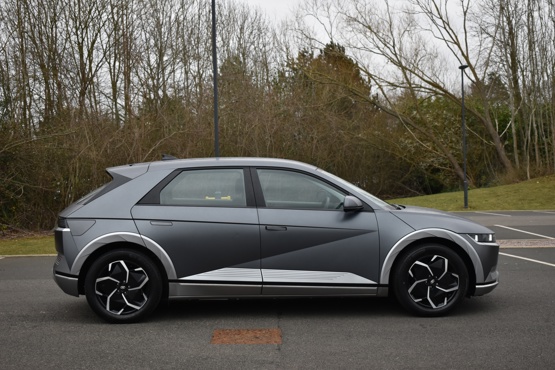
Equipment levels are generous on our model and include parking sensors and camera, electric boot, 12.3-inch infotainment/sat-nav touchscreen, blind spot alerts, forward collision avoidance (car, pedestrian and cyclist), lane keep and lane follow assist, rear cross traffic collision avoidance and Android Auto/Apple CarPlay.
First impression is the pictures do not do this car justice, in looks and – especially – size. It’s much bigger in real life; it actually has a larger footprint that the Tucson. The contemporary design features slimline grille and headlights, aggressive body creases and eye-catching alloys; inside things get even more futuristic.
We’ll be reviewing this car against two key criteria: how good it is as a full electric car versus other BEVs (usability, practicality, experience), and how good it is as a car, period. In other words, when it comes to cost, enjoyment, quality, driveability, does the Ioniq supplant petrol and diesel models or are there compromises?
Over the next six months, we’ll find out.
Specs
| Manufacturer | Hyundai |
| Model | IONIQ 5 |
| Specification | IONIQ 5 Hatch 5Dr 0.0Electric 73kWh 217 Premium Auto 22.5MY |
| Model Year | 0.00 |
| Annual VED (Road tax) | £0 |
| BIK List Price | £43,035 |
| CO2 | N/A |
| BIK Percentage | 2% |
| Insurance Group | N/A |
| CC | N/A |
| Fuel Type | Electric |
| Vehicle Type | Large family car |
| Luggage capacity (Seats up) | 5litres |
Running Costs
| P11D | £43,035 |
| Insurance group | N/A |
| Fuel Type | Electric |
| Cost per mile | 89.26ppm |
| Fuel | 4.64ppm |
| Depreciation | 83.08ppm |
| Service maintenance and repair | 1.54ppm |
Rivals
Info at a glance
-
P11D Price
£43,035
-
MPG
N/A -
CO2 Emissions
N/A -
BIK %
2% -
Running cost
3 Year 60k : N/A 4 Year 80k : N/A -
Fuel Type
Electric




